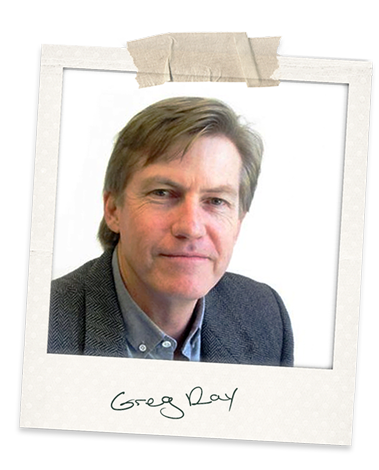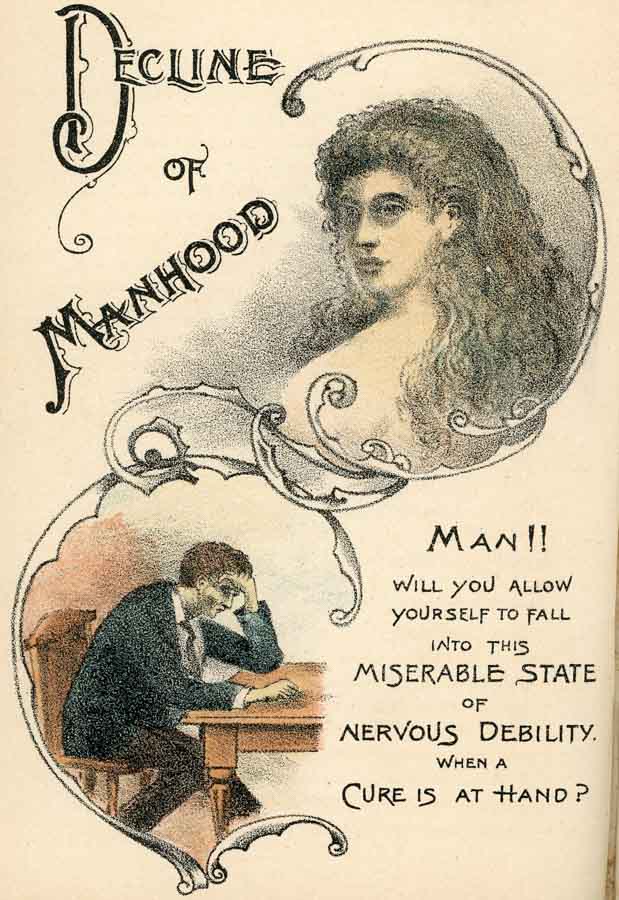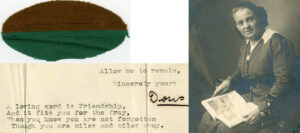I feel terribly sorry for the young men of my great grandfather’s generation: told to keep their hands above their waists on pain of a thousand terrible tortures. Not only were many young men of that era warned that “self-abuse” was immoral and likely to consign them to hellfire after death, they were also assured that the practice would stunt them physically in so many ways that blindness was probably the least of it. And to make matters worse, the people giving this wrong advice were mostly making money from the confused and worried men they were claiming to help.
Potions, elixirs, pills and weird inventions designed to stop young men from “abusing themselves” and to convince older men that their sexual dysfunctions were due to their “youthful indiscretions” and lack of willpower were pushed by quacks, some well-meaning and others not.
I hope this doesn’t seem like a prurient obsession, but over the years I have gathered a few old books that deal with the topic. The first one I found by chance, just browsing pages of an attractively bound volume called Man the Masterpiece, by the American cornflake co-inventor, John Harvey Kellogg. Kellogg was a remarkable character. He was a strict advocate of vegetarianism and clean living, and one of his motivations for inventing bland, easy-to-eat breakfast foods was the belief that these would help reduce sexual desire.
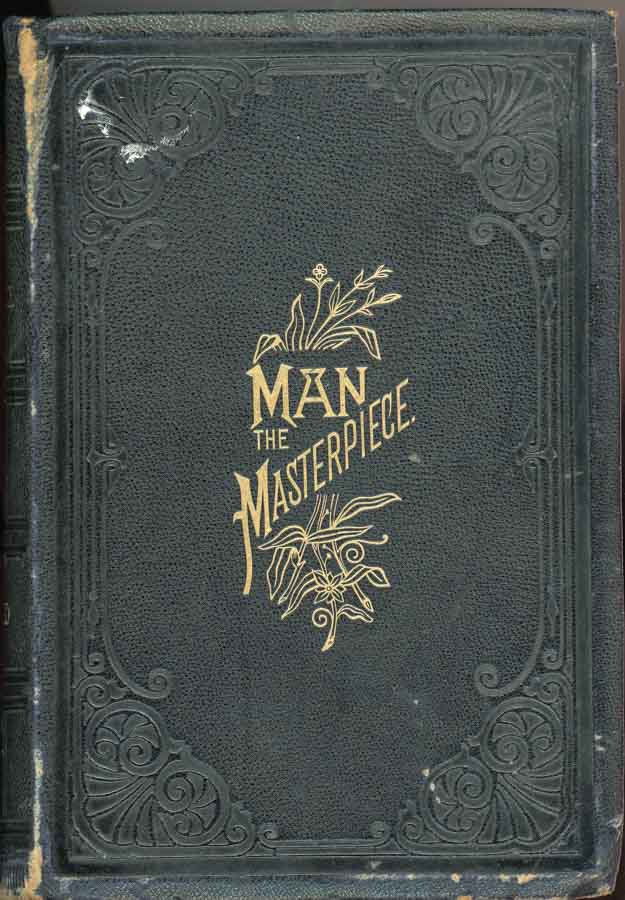
In his Man the Masterpiece or Plain Truths Plainly Told about Boyhood, Youth and Manhood, Kellogg declares that he wants to help bring on a generation of better men, and to that he aims to expose “the snares and evil enticements by which unwary youth are led astray”. It doesn’t taken many pages before Kellogg reveals that one of the main snares and enticements he is worried about is masturbation. The poor bloke, it seems, was practically obsessed with it, making it a major goal in life to persuade young men to “get their hands off it”.
Dreadful physical and moral blight
According to Kellogg: “Self-abuse, or masturbation, is probably the most common, and certainly one of the most damaging, of all forms of sexual vice.” While he acknowledged that reliable statistics on the practice were elusive, he was sure that “there can be no doubt that the evil far exceeds in magnitude the estimates of those whose opportunities for observation have not been such as to give them an adequate idea of this dreadful physical and moral blight”.
Kellogg was superintendent of the Battle Creek Sanitarium in Michigan, USA – founded by Seventh Day Adventists – and in that capacity he claimed to have discovered that masturbation was almost universal amongst boys. Few, he wrote, escaped the “moral contamination”. Believing it was less common among European peasants, he suggested that might have been because of their simpler diets – a line of thought that may have led to his co-invention of corn-flakes.
Schools were breeding grounds for masturbators, according to Kellogg, who wrote: “A boy of tender years is sent to one of these schools from the seclusion of home, where he has been carefully guarded from every taint of vice and vulgarity, and is almost instantly set upon by boys of his own age or older and instructed in the filthy practices of which they are already adepts. The little fellow, ignorant of the nature of the vice, falls an easy prey to it and only learns the evil , physical and moral, when he has become so thoroughly entangled in the toils of the habit as to make escape all but impossible; or when, at a still later hour, he awakens to the fact that his manhood is gone, his intellect weakened, and himself become a physical, mental and moral wreck.”
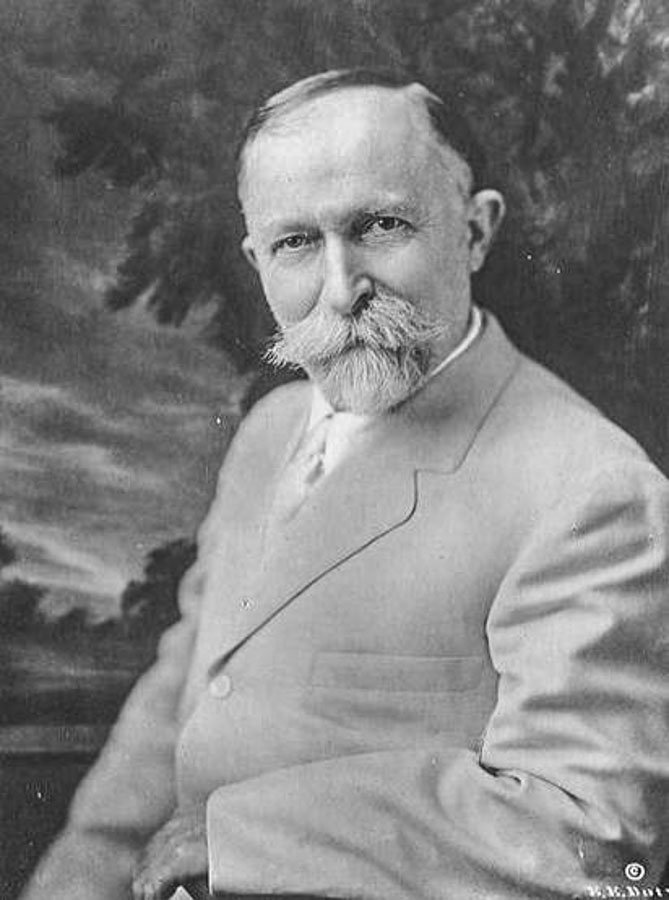
Photo from Wikipedia
Kellogg warned parents about the risks of hiring the wrong types of carers for their babies, since sometimes “even nursing infants are taught the vile practice by ignorant or wicked nurses”. His explanation for boys who started masturbating without being instructed in the practice was that some form of “local irritation of some sort will produce an abnormal excitement of the parts, which leads to the disclosure of the fatal secret” (Kellogg was also an enthusiastic supporter of circumcision).
But bad diet was the major problem, he believed. Too much meat, and especially too much tasty and spicy food “favours the early development of sexual feelings, and stimulates them in the most marked degree when once aroused,” Kellogg wrote. “The boy whose blood is made and hot and feverish with stimulating food, whose nerves are irritated and excited by mustard, pepper-sauce and other exciting condiments, is poorly prepared to resist the temptations to sexual indulgence which are certain to come to him when he mingles with other boys.”
A child that has a senile look
Kellogg warned parents to be “thoroughly conversant with the evidences by means of which the addiction to this unwholesome vice may be discovered”, but added that “only detection in the act can be considered as absolutely positive proof”. Nevertheless, he thoughtfully listed several symptoms that parents might regard as signs that their child might require “radical measures” to reform. These included change in character, sudden decline in health and precocious development. “A child that has a senile look needs looking after,” he wrote, also warning that a child who appears to be suffering from consumption (tuberculosis) might really be a victim of self-abuse. “In such a case, a physical examination of the lungs will show no disease, but a thorough investigation will disclose the fact that the individual is a masturbator”. Troublingly, Kellogg added that masturbation could actually cause consumption, so people with TB might simply have been long-term addicts to self-pleasure.
Other signs of possible masturbation-addiction included: deficiency of development, unnatural languor, unnatural timidity, an appearance of unnatural boldness, capricious appetite, round shoulders and stooping, “an unnaturally stiff, wriggling gait”, extreme nervousness and twitching of the muscles, pains in the back, weak legs, headache, enlarged veins, bed-wetting, heart palpitations, epileptic fits, sweaty palms and constant coldness.
“Little boys who show a decided preference for the society of little girls need careful watching” and “stains upon the underclothing, night clothing or bedding should be investigated”.
Kellogg acknowledged that some quacks had overdrawn the effects of the vice for mercenary reasons, but this was not as common as the opposite problem, where doctors “committed the gross error of treating the matter as of trivial importance”.
Admitting that some men appeared able to masturbate over a long period without obvious ill-effects, he warned that the worst effects could appear at any time. “The human being who gives himself up to this sort of sinful indulgence and abandons himself to the gratification of beastly lusts by these means is likely to become, sooner or later, a complete wreck physically, mentally and morally.”
An open drooling mouth
“The ultimate result of disease from this cause is imbecility or idiocy. The mental powers gradually weaken, if the habit is continued, until the brain structure becomes so seriously impaired that the individual is reduced to the level of a brute. Almost the last ray of intelligence is extinguished, and indeed in some respects the victim of this mind-destroying vice, in the last stage of his existence, may become reduced even below the level of brute creation. . . . He sits staring vacantly into space with an open drooling mouth and a senseless idiotic smile upon his face. . . . Most horrible indeed is the spectacle of a human being in ruins, brought down to this most unspeakable degradation by his own vile practices.”
But how to stop, once one has become a confirmed addict to masturbation? The cure was largely one of thinking pure thoughts and fighting the devil of temptation. But diet played a part too, with meat to be eaten sparingly and both spicy foods and sweets avoided, along with alcohol and tobacco. Also exercise of the right kind, enough sleep (not too much) and absolutely no daydreaming.
Kellogg suggested that “Starvation is one of the very best means of combating lust, and the man who finds himself well-nigh overwhelmed by temptation, whose passions have so long had the ascendency that he has become an abject slave, . . . should consider whether he cannot better, for a brief period, reduce his bill of fare to the very lowest point above starvation.”
Curing the problem in children involved, in the first instance, “moral suasion”, followed by “proper punishments”, followed by “means taken to render the practice impossible”. This might include circumcision, or perhaps “application of a blister, so as to render the parts tender and sensitive”.
A piece of wire through the foreskin
Another suggestion, which came from “Dr Archibald, superintendent of the Iowa Asylum for Feeble Minded Children”, involved sticking a piece of wire through the foreskin so it couldn’t be drawn back, effectively preventing erection. Kellogg wrote that he had employed this measure “in a number of cases with entire success”.
Naturally, such a large population of victims, warned by authoritative sources that they were destroying their lives with their sinful habit, made up a useful market for all kinds of therapies and treatments, whether dietary, surgical or medical.
Numerous books and pamphlets underscored the terrible effects that men and boys were risking, and offered solutions in return for payment.
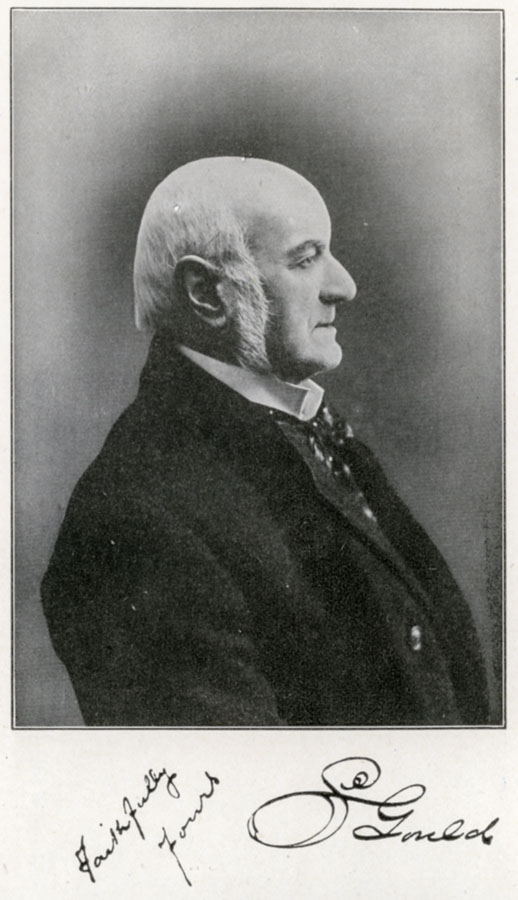
A Dr Stirling Gould, for example, published a few different versions of a book sometimes titled Useful Knowledge for Men or A treatise on Weakness in Men. In his book he made no apology for dealing with the difficult topics of “onanism, self-abuse and other indiscretions”, and quoted “a distinguished Member of the Royal College of Surgeons of England”:
“The sin of self-abuse is one of the most destructive evils ever practised by fallen man. It excites the power of nature to undue action, and produces violent secretions which necessarily and speedily exhaust the vital principles of energy; hence the muscles become flaccid and feeble, the tone and general action of the nerves relaxed and impeded, the understanding confused, the memory oblivious, the judgement perverted, the will indeterminate and wholly without energy to resist; nutrition fails, tremors, fears and terrors are generated and thus the wretched victim drags out a miserable existence till superannuated even before he has time to arrive at man’s estate, with a debilitated mind.”

Dr Gould urged parents to kindly leave a copy of his book where their sons might find it, since “if addicted to the practice, on reading the following pages he would certainly abandon it”. Essentially, the book blames masturbation and its accompanying “seminal drainage” for many illnesses including stuttering, hysteria, epilepsy, sciatica and paralysis, and especially “marital problems” such as impotence.
Naturally Dr Gould was ready with remedies from his laboratory at Bradford, and for the right money he was prepared to post these under plain wrapper. He was also willing to provide advice free by letter. Presumably the advice usually led to a sale.
If the great Kellogg was available with his sanitarium, his pieces of wire and his bland breakfasts to help the suffering masturbators of America, and if Dr Gould and his ilk were standing by with herbs and potions for self-abusers in the British Isles, we have to ask, what about Australian wankers? To whom could they turn? Well, if they were in Sydney they had the services of Dr Howard Freeman of 225 Elizabeth Street and Dr R. Wallace of 91 Pitt Street, whose brilliance was advertised in their self-published work Rescued at Last, a book for the people. My edition is dated 1898, but the foreword asserts that the book had already sold tens of thousands of copies.

Wallace and Freeman warned that “a whole brood of diseases spring out of MASTURBATION, and they are of a kind greatly to derange the functional activity and health of the organs involved, and at length to impair the constitution”.
These clever doctors were able to detect masturbators by studying a person’s diet, because “It is perfectly true . . . that all masturbating boys and girls are voracious eaters”. “One of the signs whereby we are led to decide whether or not persons are in the habit of masturbating is the peculiar craving for richly-seasoned or highly-flavoured food.”
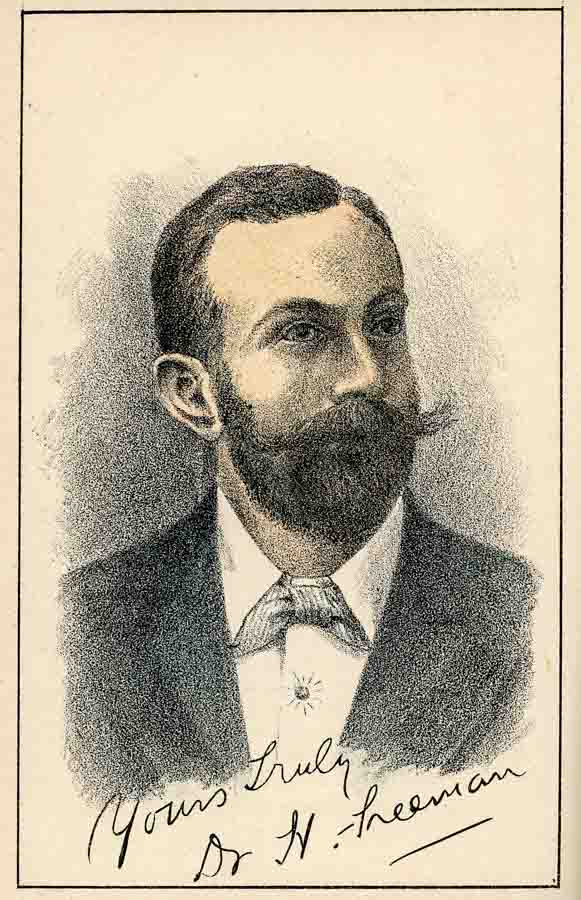

But even if they couldn’t quiz the patient about their diet, the doctors could tell by the way they walked: “Another very characteristic sign in boys and youths who practice self-abuse is a peculiar gait which they exhibit when once the habit has mastered them. One used to close inspection of such cases can tell almost at a glance the boy who has become addicted to masturbation. Such a boy when viewed from behind walks as if he were stiffened. No matter what the lad might say in the way of denial under questioning, we should never believe his protestations to the contrary as against these significant exhibitions“.
Parents who wanted the doctors to determine whether their daughters were masturbators were reassured that it was usually clear to see, even if the style of dress hid her style of walking. “Girls who have followed it from the age of ten years up to that of 17 or 18 show usually strong indications of it in the failure of their glandular developments”. They also “will be found to lie generally on the left side, with the left arm up under their heads and their bodies tipped decidedly forward, their chin resting on their breasts and their legs flexed from the hips”.
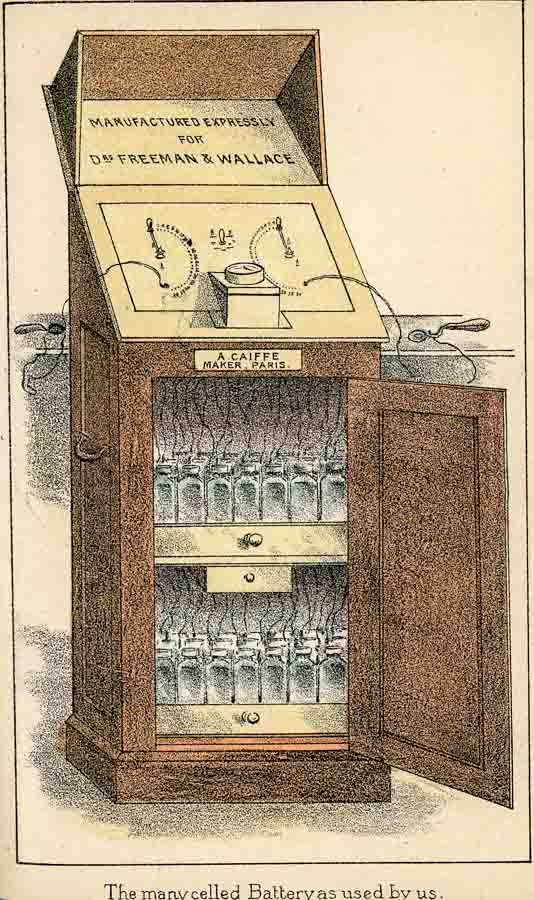
None of this was terribly important, however, since the doctors were certain they could tell a masturbator simply from looking at their face.
Wallace and Freeman spent many words in their book criticising “quacks” who published books and pamphlets in sincere tones professing to offer solutions to men suffering from the ravages of masturbation and its attendant evils. These men were villains, apparently, but Wallace and Freeman assured their readers that they were not. In addition to their own medicines Wallace and Freeman recommended electricity. By sticking electrodes in various parts of the body, it seems, they suggested they were able to cure a great many ills, including those caused by too much masturbation.
The electric points were applied
In one spectacular example cited in their book, the two doctors described the cure of a man apparently dying of a bowel complaint: “The electric points were applied, one to the tongue and the other to the anus, or bowel outlet, and after a short time there was a rumbling heard and contraction took place and in 12 hours 14lbs of faecal matter were evacuated!” Beside such a cure the restoration of rock-hard erections and lost fertility were child’s play to the wielders of the marvellous electrodes.

If a patient found it difficult to get to Sydney to have the electrodes stuck into their body by the doctors, they could save up and buy the incredible “Invigorator”, a wonderful electric belt with various attachments designed to cure just about anything. Worn discreetly under normal clothing, the Invigorator was the obvious answer to the addicted masturbator, as attested in the book by various correspondents, including the 18-year-old H.T. who, “with several other youths, practised self-pollution every day almost for years”. His remorse was something awful, and he got hold of the idea that he would never get better, but after six months wearing the Invigorator he “was so much improved that he took a billet on a station and soon got all right”.
Poor Mr J.Y. had “suffered from masturbation and was imprudently advised to get married”. Unable to satisfy his new bride, and unwilling to confess his long-running crimes of self-abuse, he was rescued by the Invigorator.
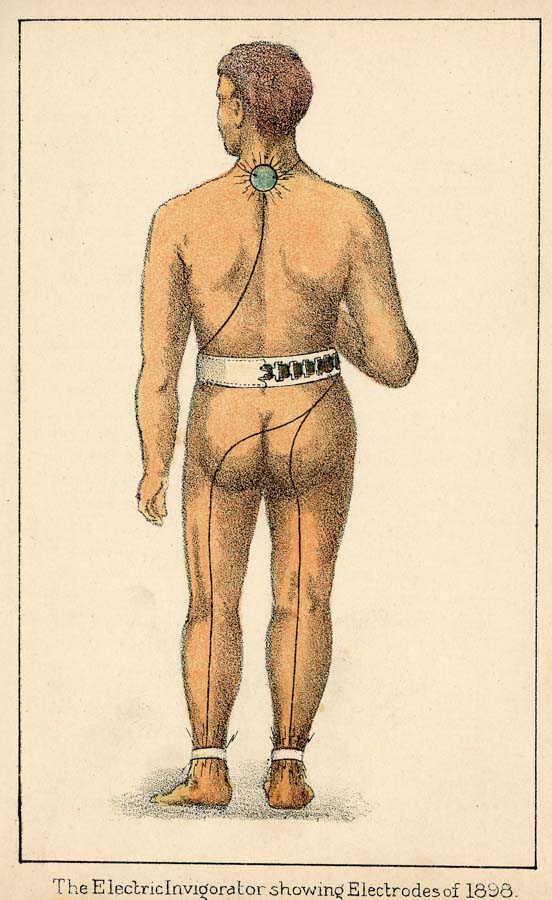
“When a patient applies to us for a belt we supply him with an INVIGORATOR of a grade of electric force suited to his special case and fitted with a suspensory, similarly graded and removable at will, for the support and stimulation of the generative organs,” the authors promised.
Perhaps not surprisingly, some purveyors of non-electrical treatments might have felt that people such as Wallace and Freeman were treading on their patch. Our friend Dr Gould, at the end of his little book, observed that he received many letters from his worried clientele asking about electric belts.
“I may say I have no desire to pass an opinion, as my opinion might seem prejudiced. But in the great Electric Belt Case, in the High Court of Justice some years ago, undoubted evidence was given by medical experts and scientists to the effect that electricity as applied by means of a belt could not be utilised to have any beneficial or curative power on ailing humanity and the verdict went against the Electric Belt Co and electric belts were no more heard of in this country until recently,” Gould wrote.
Much more detail about Wallace and Freeman can be found in the very interesting book Kill or Cure, Lotions, Potions, Characters and Quacks of Early Australia, by Peter J. Phillips.
Inventing diseases to profit from curing: it’s popular even today, according to some. One can only imagine the mental anguish caused by the inventors of the disease of “self-abuse”.
I’ve encountered a handful of accounts of what it was like to believe this stuff. One is Frank Harris’s notorious autobiography, My Life and Loves, which is packed with wankophobia – in addition to Harris’s awful name-dropping and self-promotion. Another is Gavin Maxwell’s “autobiography of childhood”, The House of Elrig, published in 1965. Maxwell, famous for the superb Ring of Bright Water, describes his youthful bewilderment about the well-intentioned but obscure advice of adults in his life, many of whom were anxious to warn him against masturbation but couldn’t quite bring themselves to describe what it was they were trying to stop him doing. His mother gave him one of those awful books, What a Young Boy Ought to Know, which he said had been written by “two doctors who had somehow escaped certification as insane” and which “must have caused misery to an incalculable number of boys”, with all the (then) usual warnings of horrific consequences for boys who touched their private parts.
Maxwell, with disarming frankness, describes his accidental discovery of orgasm and the tortured battle he fought and lost, again and again, to avoid deliberately repeating the pleasure – while convinced he was destroying his mind and his bodily health in the process. Fortunately he was intelligent enough to apply the unrelated advice of a schoolmaster who advised him in general terms to “use your brains on everything you are told”. Having by now read many more books than What a Young Boy Ought to Know, he was able to rationally demolish the nonsense it contained and eventually move on.

This World War 2 Australian publication was issued by the “Father and Son Welfare Movement and League of Youth and Honour”. Its main goal appears to have been to warn against venereal diseases but it also counselled young males to keep their hands out of their pants. “Many boys,” author P.J.L. Kenny warned, “acquire a habit of over-handling their sex organs and causing the penis to erect itself and eject the secretion.” “This is a stupid childish act and those who do it find that they cannot concentrate on their lessons or any work they may have to do, and that their memory fails them when they most need it. It tend too, to make a boy nervy and irritable.”
Creditably, Kenny reassured readers that “the habit, however, does not cause insanity, consumption or other dreadful diseases, as so many books on the subject state.” “The fact that a boy has masturbated or committed self-abuse – as this habit is called – and ceased to do so, will not affect his health in manhood or render fatherhood impossible”. Nevertheless, he urged boys to “give the sex organs the chance by non-interference, to do their job to make you strong, healthy and virile, to make you a man, a WORTH-WHILE MAN, with full physical and mental integrity”.

In more recent times various Christian churches have weighed in on the masturbation debate, and this helpful pamphlet from the Catholic Truth Society (illustrated above) may be typical. In its advice to boys it observes that they should not be worried when “this part of your body sometimes becomes excited“. Sensibly, the pamphlet notes that “it is quite natural“, but then goes on to say that “the best thing to do is to take no notice of it or any slight pleasure you may feel in it”. “Turn your mind to something else,” is the advice, along with: “Say a prayer to Our Lord or Our Lady, turn over at once, and think of something else.” “Impurity is the selfish enjoyment of these pleasures when we have no right to them”. Young readers were advised to say, each night, “one Hail Mary to Our Lady for the grace to keep pure”.
Exhortations to celibacy and purity do not seem to have done the trick for at least a portion of the church hierarchy, unfortunately.
